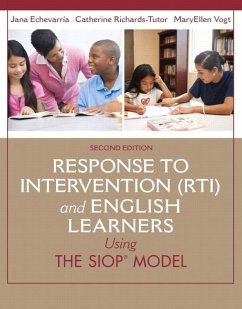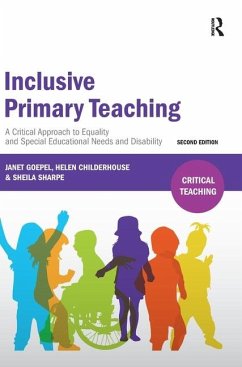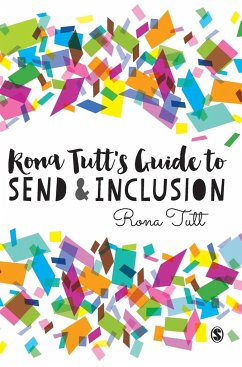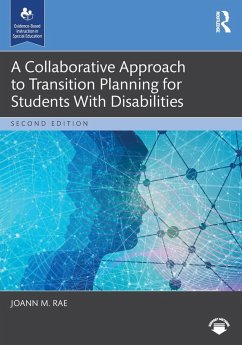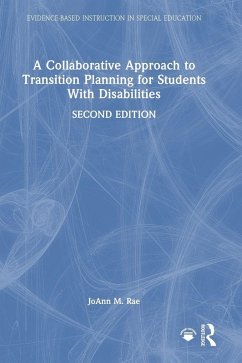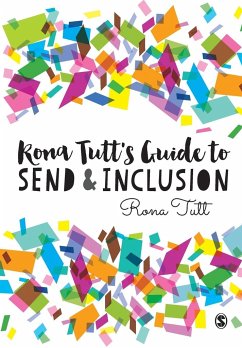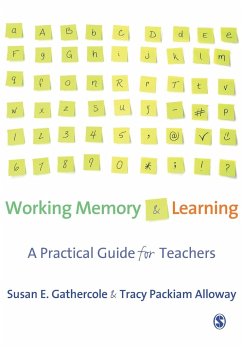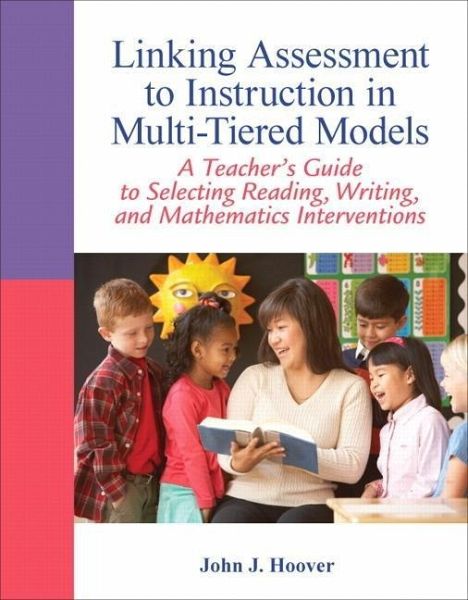
Linking Assessment to Instruction in Multi-Tiered Models
A Teacher's Guide to Selecting, Reading, Writing, and Mathematics Interventions
Versandkostenfrei!
Versandfertig in über 4 Wochen
58,99 €
inkl. MwSt.

PAYBACK Punkte
29 °P sammeln!
For courses in General Methods and Response to Intervention.
This book shows classroom teachers how to direct multi-tiered instruction by linking screening, monitoring and diagnostic achievement scores with evidence-based interventions in reading, writing, and mathematics.
Organized in two parts, it explores the multi-tiered instructional model found within the RTI framework and how to best implement it in the classroom setting. Beyond a theoretical perspective, it shows teachers which evidence-based interventions should be attempted based on specific achievement data and related progress scores. It includes reading, writing, and mathematics interventions that can be used for core Tier 1 instruction, supplemental Tier 2 supports and intensive Tier 3 interventions. Throughout the book, its emphasis is on using assessment data to make important instructional decisions that meet learner needs.
Product Description
With a unique classroom focus, Linking Assessment to Instruction in Multi-Tiered Models, 1e shows teachers how to direct multi-tiered instruction and adjust their teaching based on screening, monitoring and diagnostic achievement scores. Beyond a theoretical perspective, this two-part text explores the multi-tiered instructional model found within the RTI framework and how to best implement it in the classroom setting. It includes reading, writing, and mathematics interventions that can be used for core Tier 1 instruction, supplemental Tier 2 supports and intensive Tier 3 interventions. Throughout the book, its emphasis is on using assessment data to make important instructional decisions that meet learner needs.
Features + Benefits
Speaks directly to the classroom teacherby showing them which evidence-based interventions should be attempted in multi-tiered models prior to referral to special education.
Links achievement data with evidence-based interventions so teachers know how to adjust their instruction once assessment information is available.
Covers reading, writing, and mathematics interventions in a single volume so teachers have numerous, structured instruction strategies right at their fingertips.
Includes chapter overviews, key terms, and numerous figures, tables, charts and guides to make strategies more applicable.
Offers 96 interventions to use in multi-tiered instruction including:
o 16 proven classroom and instructional management techniques
o 27 evidence-based reading, writing, mathematics structured interventions
o 30 proven student study skills and strategies
o 23 research-based reading, writing, mathematics curricula to meet learning needs
Backcover
With a unique classroom focus, Linking Assessment to Instruction in Multi-Tiered Models, 1e shows teachers how to direct multi-tiered instruction and adjust their teaching based on screening, monitoring and diagnostic achievement scores. Beyond a theoretical perspective, this two-part text explores the multi-tiered instructional model found within the RTI framework and how to best implement it in the classroom setting. It includes reading, writing, and mathematics interventions that can be used for core Tier 1 instruction, supplemental Tier 2 supports and intensive Tier 3 interventions. Throughout the book, its emphasis is on using assessment data to make important instructional decisions that meet learner needs.
Features
Speaks directly to the classroom teacherby showing them which evidence-based interventions should be attempted in multi-tiered models prior to referral to special education.
Links achievement data with evidence-based interventions so teachers know how to adjust their instruction once assessment information is available.
Covers reading, writing, and mathematics interventions in a single volume so teachers have numerous, structured instruction strategies right at their fingertips.
Includes chapter overviews, key terms, and numerous figures, tables, charts and guides to make strategies more applicable.
Offers 96 interventions to use in multi-tiered instruction including:
o 16 proven classroom and instructional management techniques
o 27 evidence-based reading, writing, mathematics structured interventions
o 30 proven student study skills and strategies
o 23 research-based reading, writing, mathematics curricula to meet learning needs
PART I - Framework, Process and Collaboration in Multi-tiered Instructional Models
Chapter 1: Structure of Multi-Tiered Instructional Models
Chapter Overview/Key Terms
Overview of Multi-Tiered Instructional Models
Conclusion
Chapter 2: Process of Multi-Tiered Instructional Models
Chapter Overview/Key Terms
Introduction
Multi-Tiered Instructional Delivery Process
Multi-Tiered Assessment Process
Interpreting Achievement Data Scores
Framework for Making Instructional Adjustments
Universal Screening and Progress Monitoring Example: AIMSweb
Conclusion
Chapter 3: Collaboration to Implement Instructional Adjustments
Chapter Overview/Key Terms
Introduction
Collaboration Model
Facilitating Change
Conclusion
Part II: Reading, Writing, and Mathematics Interventions
Chapter 4: Evidence-Based Reading Practices
Chapter Overview/Key Terms
Introduction
Foundations of Reading Instruction
Reading Interventions
Research-Based Comprehensive Reading Programs
Teacher and Student Strategies for Differentiated Reading Instruction
Conclusion
Chapter 5: Evidence-Based Writing Practices
Chapter Overview/Key Terms
Introduction
Writing as a Process
Foundational Elements of Effective Writing
Writing Interventions
Comprehensive Writing Programs
Strategies for Differentiated Writing Instruction
Conclusion
Chapter 6: Evidence-Based Mathematics Practices
Chapter Overview/Key Terms
Foundation of Mathematics Instruction
Mathematics and Use of Mental Processes
Evidence-Based Mathematics Instruction
Comprehensive Mathematics Instructional Support Programs
Strategies for Differentiated Mathematics Instruction
Conclusion
Concluding Remarks: Meeting the Classroom Challenges of Multi-Tiered Instruction
References
This book shows classroom teachers how to direct multi-tiered instruction by linking screening, monitoring and diagnostic achievement scores with evidence-based interventions in reading, writing, and mathematics.
Organized in two parts, it explores the multi-tiered instructional model found within the RTI framework and how to best implement it in the classroom setting. Beyond a theoretical perspective, it shows teachers which evidence-based interventions should be attempted based on specific achievement data and related progress scores. It includes reading, writing, and mathematics interventions that can be used for core Tier 1 instruction, supplemental Tier 2 supports and intensive Tier 3 interventions. Throughout the book, its emphasis is on using assessment data to make important instructional decisions that meet learner needs.
Product Description
With a unique classroom focus, Linking Assessment to Instruction in Multi-Tiered Models, 1e shows teachers how to direct multi-tiered instruction and adjust their teaching based on screening, monitoring and diagnostic achievement scores. Beyond a theoretical perspective, this two-part text explores the multi-tiered instructional model found within the RTI framework and how to best implement it in the classroom setting. It includes reading, writing, and mathematics interventions that can be used for core Tier 1 instruction, supplemental Tier 2 supports and intensive Tier 3 interventions. Throughout the book, its emphasis is on using assessment data to make important instructional decisions that meet learner needs.
Features + Benefits
Speaks directly to the classroom teacherby showing them which evidence-based interventions should be attempted in multi-tiered models prior to referral to special education.
Links achievement data with evidence-based interventions so teachers know how to adjust their instruction once assessment information is available.
Covers reading, writing, and mathematics interventions in a single volume so teachers have numerous, structured instruction strategies right at their fingertips.
Includes chapter overviews, key terms, and numerous figures, tables, charts and guides to make strategies more applicable.
Offers 96 interventions to use in multi-tiered instruction including:
o 16 proven classroom and instructional management techniques
o 27 evidence-based reading, writing, mathematics structured interventions
o 30 proven student study skills and strategies
o 23 research-based reading, writing, mathematics curricula to meet learning needs
Backcover
With a unique classroom focus, Linking Assessment to Instruction in Multi-Tiered Models, 1e shows teachers how to direct multi-tiered instruction and adjust their teaching based on screening, monitoring and diagnostic achievement scores. Beyond a theoretical perspective, this two-part text explores the multi-tiered instructional model found within the RTI framework and how to best implement it in the classroom setting. It includes reading, writing, and mathematics interventions that can be used for core Tier 1 instruction, supplemental Tier 2 supports and intensive Tier 3 interventions. Throughout the book, its emphasis is on using assessment data to make important instructional decisions that meet learner needs.
Features
Speaks directly to the classroom teacherby showing them which evidence-based interventions should be attempted in multi-tiered models prior to referral to special education.
Links achievement data with evidence-based interventions so teachers know how to adjust their instruction once assessment information is available.
Covers reading, writing, and mathematics interventions in a single volume so teachers have numerous, structured instruction strategies right at their fingertips.
Includes chapter overviews, key terms, and numerous figures, tables, charts and guides to make strategies more applicable.
Offers 96 interventions to use in multi-tiered instruction including:
o 16 proven classroom and instructional management techniques
o 27 evidence-based reading, writing, mathematics structured interventions
o 30 proven student study skills and strategies
o 23 research-based reading, writing, mathematics curricula to meet learning needs
PART I - Framework, Process and Collaboration in Multi-tiered Instructional Models
Chapter 1: Structure of Multi-Tiered Instructional Models
Chapter Overview/Key Terms
Overview of Multi-Tiered Instructional Models
Conclusion
Chapter 2: Process of Multi-Tiered Instructional Models
Chapter Overview/Key Terms
Introduction
Multi-Tiered Instructional Delivery Process
Multi-Tiered Assessment Process
Interpreting Achievement Data Scores
Framework for Making Instructional Adjustments
Universal Screening and Progress Monitoring Example: AIMSweb
Conclusion
Chapter 3: Collaboration to Implement Instructional Adjustments
Chapter Overview/Key Terms
Introduction
Collaboration Model
Facilitating Change
Conclusion
Part II: Reading, Writing, and Mathematics Interventions
Chapter 4: Evidence-Based Reading Practices
Chapter Overview/Key Terms
Introduction
Foundations of Reading Instruction
Reading Interventions
Research-Based Comprehensive Reading Programs
Teacher and Student Strategies for Differentiated Reading Instruction
Conclusion
Chapter 5: Evidence-Based Writing Practices
Chapter Overview/Key Terms
Introduction
Writing as a Process
Foundational Elements of Effective Writing
Writing Interventions
Comprehensive Writing Programs
Strategies for Differentiated Writing Instruction
Conclusion
Chapter 6: Evidence-Based Mathematics Practices
Chapter Overview/Key Terms
Foundation of Mathematics Instruction
Mathematics and Use of Mental Processes
Evidence-Based Mathematics Instruction
Comprehensive Mathematics Instructional Support Programs
Strategies for Differentiated Mathematics Instruction
Conclusion
Concluding Remarks: Meeting the Classroom Challenges of Multi-Tiered Instruction
References
For courses in General Methods and Response to Intervention.
This book shows classroom teachers how to direct multi-tiered instruction by linking screening, monitoring and diagnostic achievement scores with evidence-based interventions in reading, writing, and mathematics.
Organized in two parts, it explores the multi-tiered instructional model found within the RTI framework and how to best implement it in the classroom setting. Beyond a theoretical perspective, it shows teachers which evidence-based interventions should be attempted based on specific achievement data and related progress scores. It includes reading, writing, and mathematics interventions that can be used for core Tier 1 instruction, supplemental Tier 2 supports and intensive Tier 3 interventions. Throughout the book, its emphasis is on using assessment data to make important instructional decisions that meet learner needs.
This book shows classroom teachers how to direct multi-tiered instruction by linking screening, monitoring and diagnostic achievement scores with evidence-based interventions in reading, writing, and mathematics.
Organized in two parts, it explores the multi-tiered instructional model found within the RTI framework and how to best implement it in the classroom setting. Beyond a theoretical perspective, it shows teachers which evidence-based interventions should be attempted based on specific achievement data and related progress scores. It includes reading, writing, and mathematics interventions that can be used for core Tier 1 instruction, supplemental Tier 2 supports and intensive Tier 3 interventions. Throughout the book, its emphasis is on using assessment data to make important instructional decisions that meet learner needs.



